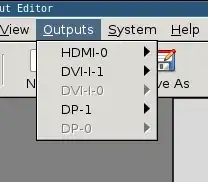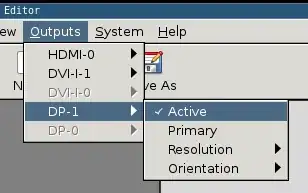I've installed Ubuntu 16.04, and I had all three of my monitors working gracefully (it didn't quite work out of the box, but a little monkeying with the drivers soon straightened everything out). I've installed i3-wm, but it doesn't recognize my third monitor. I had i3-wm working without any problems on my previous Ubuntu 14.04 installation, and whenever I log out of i3-wm, my computer recognizes my third monitor again (i.e. I don't think there's any fault with the hardware).
I've tried unplugging / replugging my third monitor, restarting i3-wm, and rebooting several times without any success. Any thoughts on what might be problem?
Thanks!
P.S. My third monitor is 4k (rotated) and connected through Display Port. My other two (working) monitors, both 1080p, connect through HDMI and DVI.
Edit: I ran xrandr, and here's the output:
Screen 0: minimum 8 x 8, current 3840 x 1080, maximum 16384 x 16384
DVI-I-0 disconnected primary (normal left inverted right x axis y axis)
DVI-I-1 connected 1920x1080+0+0 (normal left inverted right x axis y axis) 509mm x 286mm
1920x1080 60.00*+
1680x1050 59.95
1440x900 59.89
1280x1024 75.02 60.02
1280x960 60.00
1280x800 59.81
1280x720 60.00
1152x864 75.00
1024x768 75.03 70.07 60.00
800x600 75.00 72.19 60.32 56.25
640x480 75.00 59.94
DP-0 disconnected (normal left inverted right x axis y axis)
HDMI-0 connected 1920x1080+1920+0 (normal left inverted right x axis y axis) 509mm x 286mm
1920x1080 60.00*+ 59.94 50.00 60.00 50.04
1680x1050 59.95
1440x900 59.89
1280x1024 75.02 60.02
1280x960 60.00
1280x800 59.81
1280x720 60.00 59.94 50.00
1152x864 75.00
1024x768 75.03 70.07 60.00
800x600 75.00 72.19 60.32 56.25
720x576 50.00
720x480 59.94
640x480 75.00 59.94 59.93
480x576 50.00
480x480 59.94
DP-1 connected (normal left inverted right x axis y axis)
3840x2160 60.00 + 29.98
2560x1440 59.95
1920x1200 59.88
1920x1080 60.00 59.94 50.00 23.97 60.00 50.04
1680x1050 59.95
1600x1200 60.00
1280x1024 75.02 60.02
1280x800 59.81
1280x720 60.00 59.94 50.00
1152x864 75.00
1024x768 75.03 60.00
800x600 75.00 60.32
720x576 50.00 50.08
720x480 59.94 60.05
640x480 75.00 59.94 59.93
Notably, "DP-0 disconnected (normal left inverted right x axis y axis)" (DP would be Display Port - meaning that my 4k display port monitor is not connected). Interestingly enough, there is a DP-1 option which is connected.
I also ran arandr, but like my i3-wm, it only recognized the 1080p monitors. I find it very strange that xrandr detects a monitor (connected through DP-1) that arandr doesn't.

